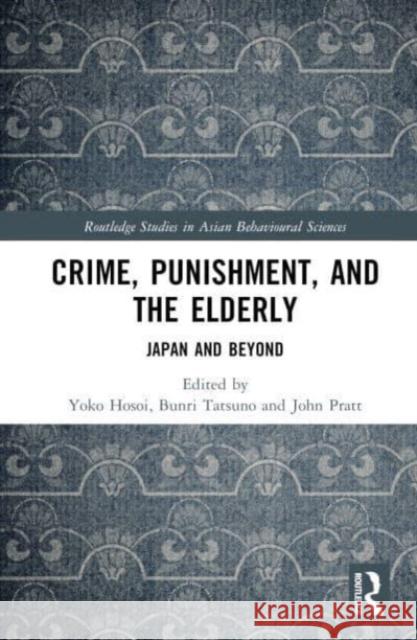Crime, Punishment, and the Elderly » książka



Crime, Punishment, and the Elderly
ISBN-13: 9781032669489 / Twarda / 2024 / 272 str.
Hosoi, Tatsuno and Pratt examine the realities, problems and backgrounds of crimes committed by elderly people in both Japan and international perspectives.
Wydanie ilustrowane
Contents
Preface
Introduction
1. What is the current issue: Indications by Western researchers
2. Theoretical framework of the research: Focusing on the concept of “Lifeworld”
Section 1: Considering the Society and Elderly Criminals
Chapter 1. Social Circumstances Surrounding the Elderly: Twenty-year Trends
1. Changes in population composition
2. Changes in social security schemes
3. The arrival of a society of disparities
4. Two miscalculations pertaining to a Japanese-type welfare society
Chapter 2. Study of Social Exclusion and Inclusion in a Post-Welfare State Society: From C. Gilligan's Perspective of "Care"
The problem of aging and social reintegration
1. From the dilemma of moral norms to the relationship of support
2. From the second modern age to the third
3. Vulnerability and inclusion
4. Social Inclusion of deviant individuals
Chapter 3. The Actual Situation of Crimes by the Elderly in Japan: Based on Crime Statistics, the Ministry of Justice's Research Report, and Special Investigation
1. Overview of crime statistics
3. Recidivism on the part of elderly criminals
Chapter 4. Reintegrating Elderly Criminals into the Society: From the Standpoint of Judicial Welfare
2. Rehabilitation process of elderly ex-criminals observed in the interview-based survey
3. How to see elderly criminals
4. Policy on the reintegration of elderly criminals and perpetrators into society
4. Life of elderly ex-criminals
Chapter 6. Duplication of Social Poverty: Elderly Criminals and Homeless People
1. Post-modernity and selective relationship that becomes the mainstream in society
2. Social poverty: Homeless people and elderly crimes
3. Two types of support for elderly criminals: Judicial and welfare system collaboration
4. Life history and social rehabilitation of elderly criminals: A case study
1. Summary of the elderly inmate surveys (2012 Survey, 2016 Survey, and 2017 Survey)
2. Results of and discussion concerning the 2016 survey
3. Results of and discussion concerning the 2017 survey
4. Summary of the “Survey of Elderly Inmates”
1. Four types of elderly convicts – “the 2012 survey”
2. Through a “free-answer survey” of previous term’s elderly convicts (40 years and older)
Chapter 3: The Needs of Restorative Justice for Senior Criminal Women in Japan
Severe punishment, medicalization, or restorative justice?
Chapter 4: Social Position and “Self Perception” of Elder Female Inmates
3. Female prisoners and the underclass
4. "Female prisoners" and "general female workers"
Section III Trends and Issues in Elderly Crime From Around the World
2. The current situation of elderly convicts in New Zealand
3. Sexual crimes and laws in New Zealand
4. Recent legislation related to sexual crimes in New Zealand
Chapter 2: ‘No Country for Old Men.’ The Experiences of Elderly Inmates in New Zealand
1. The pains of imprisonment as experienced by elderly inmates
Chapter 3. The State of Elderly Criminals in Australia
2. Aging and social security situation in Australia
3. Situation of elderly criminals
Chapter 4. Older Prisoners in New South Wales, Australia
4. Preliminary survey analysis
Chapter 5. Rehabilitation Services for Elderly Prisoners in Hong Kong
2. The correctional services in Hong Kong
3. Tailor-made services for elderly prisoners –The Evergreen Garden
4. Hong Kong elderly prisoners survey
Chapter 6. Trends in the Aging Prison Population of England and Wales
2. Background of crimes by older people and incarceration
3. Re-entry/resettlement of elderly prisoners
Chapter 1. Comparison between New Zealand and Japan
1. A comparison between characteristics of elderly convicts from Japan and New Zealand
Chapter 2. Comparison of prisoners in New Zealand, Hong Kong, Australia, and Japan
Summary and Conclusions: What We Learn and Pass on from Research on Elderly Crimes
1. Social background for the increase of theft and its repetition in Japan
3. The lifeworld of elderly criminals: A joint survey of Japan and New Zealand
4. Crimes by elderly women: Women’s unique life course and awakening of the “self”
6. Rehabilitation process of elderly criminals: How to expand “self-reliance”
Yoko Hosoi is Emeritus Professor of Sociology at Toyo University, Tokyo, Japan.
Bunri Tatsuno is an adjunct researcher in Criminal Justice Policy at Kokushikan University, Japan.
John Pratt is Emeritus Professor of Criminology at the Institute of Criminology, Victoria University of Wellington, New Zealand
1997-2025 DolnySlask.com Agencja Internetowa
KrainaKsiazek.PL - Księgarnia Internetowa









